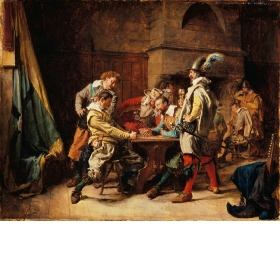Jenkins meets Captain Rowland Gwatkin, the commander of his company, early in VB, and Gwatkin is a central character of this volume.
Jenkins reflects on Gwatkin: “There was an air of resolve about him, the consciousness of playing a part to which a high destiny had summoned him. I suspected he saw himself in much the same terms as those heroes of Stendhal – not a Stendhalian lover, like Barnby, far from that – an aspiring, restless spirit, who, released at last by war from the cramping bonds of life in a provincial town, was about to cut a dashing military figure against a back-cloth of Meissonier-like imagery of plume and breastplate: dragoons walking their horses through the wheat, grenadiers at ease in a tavern with girls bearing flagons of wine.” [VB 17-18/13]

Halt at an Inn
Jean-Louis Ernest Meissonier ~1862-1863
oil on panel, 8 x 10 in
The Wallace Collection
photo in the public domain from Athenaeum.org

The Guard Room
Jean-Louis Ernest Meissonier ~1847
oil on panel, 6 x 8 in
The Wallace Collection
photo in the public domain from Athenaeum.org
Jean-Louis Ernest Meissonier (French 1815-1891) painted small, detailed genre scenes, reminiscent of the seventeenth century Dutch style, purportedly because they fit the walls of Parisian apartments and sold much better than more grandiose canvases. Ruskin praised his work; his prices soared during his lifetime; at age 14, Proust called Meissonier his favorite painter, but Meissonier’s reputation was eclipsed by the Impressionists. We show Halt at an Inn and The Guard Room, now among 17 Meissoniers in The Wallace Collection, because Powell was very familiar with The Collection and was a great friend of its curator. (Between November, 2005, and February, 2006, The Wallace Collection mounted a special exhibition Dancing to the Music of Time: The Life and Work of Anthony Powell.) Perhaps Powell imagined the grenadiers at the tavern based on small panel paintings like these.

The Lost Game, Jean-Louis Ernest Meissonier, 1858, oil on mahogany panel, image size 8 x 10 in, The Wallace Collection https://i1.wp.com/picturesinpowell.files.wordpress.com/2015/06/lost-game.jpg?ssl=1
In Album, Lady Violet Powell chooses The Lost Game, also in the Wallace Collection, as her illustration of this passage.

1807, Friedland
Jean-Louis Ernest Meissonier – 1875
oil on canvas, 54 x 100 in
Metropolitan Museum, New York
photo in public domain from The Anthenaeum.org
Later in his career, Meissonier turned to painting larger canvases of scenes from military history. In 1859, he was commissioned by Napoleon III to illustrate some of his military campaigns. These military canvases show many dashing figures for Gwatkin to emulate.
